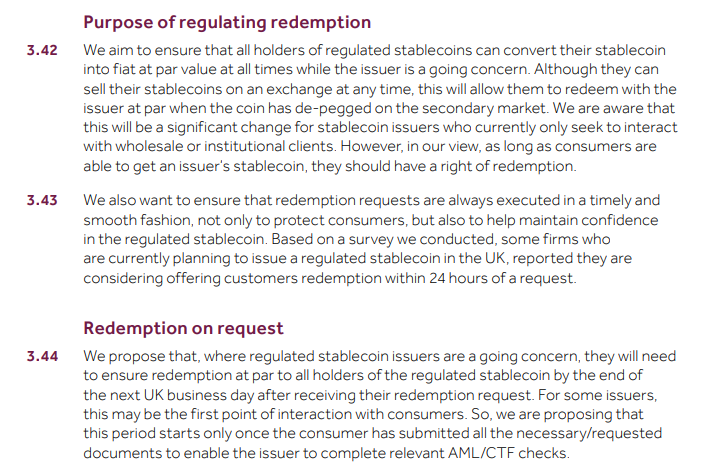-
Share on Facebook
-
Share on Twitter
-
Share on LinkedIn
-
Copy link
Copied to clipboard
UK regulation latest: phase-1 and stables
One of the most common misapprehensions we tend to see, with respects to the general regulatory approach towards crypto in Britain, is that Britain has tended to be a poor place to do crypto business over the last few years. Practically speaking, this is nonsense, and betrays something of a misunderstanding of how business is done in the UK compared to other jurisdictions; the financial regime here is very much one of harm prevention, with the focus being on protecting the end consumer and with much of the rest summing up to noise.

Executive Summary
-
UK lawmakers and regulators continue to move forward on crypto regulation.
-
Multiple bodies put out guidance on 'phase-1' proposals over the last week.
-
Our view: generally positive, some concerning points around custody and redemption.
One of the most common misapprehensions we tend to see, with respects to the general regulatory approach towards crypto in Britain, is that Britain has tended to be a poor place to do crypto business over the last few years. Practically speaking, this is nonsense, and betrays something of a misunderstanding of how business is done in the UK compared to other jurisdictions; the financial regime here is very much one of harm prevention, with the focus being on protecting the end consumer and with much of the rest summing up to noise.
Nonetheless, the last couple of years have seen many businesses locally run into the limits of that approach, and it would be fair to say that a lot of firms in the UK are very much now poised on tenterhooks, waiting for clarification and a new regulatory regime since roughly the start of the FCA temporary registration scheme in 2020. As we have documented over the last year, concrete steps are being taken towards that now, with the passage of the Financial Services and Markets Act 2023 (bringing crypto assets under the aegis of financial regulators) and a flurry of activity in order to build a sensible regulatory regime towards that.
It does need to be emphasised here that regulators currently have something of a new football manager effect going on at the moment; for the most part, we are still in the consultation stage of the formalisation of these regulations, with the first very broad statements of intents starting to come into place now. A few documents have come out to that effect over the past few weeks, with the most recent ones being a series of documents from various regulatory and financial bodies on Monday, all discussing the question of stablecoins and their role under the future regulatory regime.
While said documents are mostly still fairly vague, we do feel that there are a few verticals in particular worth highlighting – both for what is being said, and for divining broader regulatory intentions as we move towards a new regime (said documents are talking about 2025 as a likely date for implementation).
Custody and redemption

One of the bolder parts of the FCA’s contribution to the discussion here is this: an effort to enshrine direct creation and redemption as a necessary requirement for stablecoins.
At first glance, this might not seem that odd; after all, stables are 1:1 or more backed in their native currency, both in terms of how they practically work, and in terms of the FCA’s definition here (as we will note later, stables outside of that strict definition are, in their eyes, not considered stables at all). Further, it is easy to see the inspiration here; as both we and other commentators like Sean Tuffy have noticed, this is a very similar treatment to how ETPs work in the UK and in mainland Europe, and there is something intuitively sensible to treating stables as a single-asset basket.
Of course, intuition is not always sensible. The basic structure of stablecoin issuers involves taking in stables and employing that money productively; while the requirement to redeem should under basically no circumstances cause a problem for a legitimate issuer as long as the T+X expectations are sufficiently sane, an extremely strict implementation of that idea could cause problems, as could the scaling of the KYC and AML regime necessary to be able to service on-demanded a retail-scale client base.
This is firmly one of those things where the letter of the law could turn out entirely reasonable, but it is one point that catches the eye with regards to potential difficulties at this early stage. A similar point is the BoE’s proposal to basically take over full custody of stablecoins: “We propose that issuers would be required to fully back stablecoins with deposits at the Bank of England. No interest would be paid on these deposits.”
As far as we can tell, this sentiment does not appear outside of the FCA’s proposals, which is generally a good thing, because it is a transparently idiotic one that undermines the ability and reason to run a stablecoin business in the first place. Points like these will be important to watch for as we move past statements of intent and towards formalisation of future rules.
Crypto-backed stables

One of the most interesting features of the FCA documentation was the lengths gone to in order to establish a distinction between ‘fiat-backed stablecoins’ (i.e. stablecoins with a particular fiat value and backed wholly or in part by said fiat) and any other products including algostables, commodity-backed stables, and seemingly coins like e.g. ETH-collateralised stables.
To be clear, the latter categories are being excluded because of the intention that they be regulated in phase 2 (with crypto assets in general) instead of phase 1; still, the fact that such a distinction is being made is worthy of note.
We have seen a significant shift in the industry over the last few years away from crypto-native backing mechanisms on the grounds that said mechanisms are capital-inefficient and fail to capture potential yields from RWA, at the price of increasing centralisation risk – something felt acutely earlier in the year when USDC depegged during the Silicon Valley Bank crisis. It does not seem inconceivable that we could start to see things shift the other way should regulatory regimes – which, it has to be remembered, are currently near-non-existent on stables in general – attempt to restrict fiat-based stables to too great of a degree.
The digital pound: does anyone care?
To finish, a few thoughts on GBP stablecoins and the ‘digital pound’.
The general assumption is that governments are generally hostile to stablecoins (being that they are private money, and being that it takes control out of their hands). This seems fair towards the BoE, but a little harsh towards the FCA, at least in this instance; overall this has the seeds of a good-faith effort towards sensible regulation of global stables.
Note here that we say global stables, because the restrictions being put into place for a stablecoin issuer operating in the UK seem to us to be harsh – harsh enough, in fact, to discourage them from existing entirely. The easy jump of logic from there would be to start talking about CBDCs and how the UK regulator wants a ‘digital pound’ to only exist within their systems.
How do we map the good-faith approach to global (i.e. USD) stables and bad-faith approach to local (i.e. GBP) stables onto one another? We tend to think of it in terms of ‘stables as a service’. The rules set out here seem to be that any ‘stablecoin’ business set up in the UK operates more as an execution agent instead – facilitating moves in and out of GBP equivalents without holding significant reserves of said assets.
This is probably sensible, and a surprisingly good read of the status of GBP (and indeed all non-USD currencies) within crypto and within an increasingly crypto-native world. It cannot be emphasised enough: every attempt to de-dollarise the crypto economy has been an absolutely abject failure to date, because no matter how well-backed they may be, the crypto economy – as with the global economy – naturally gravitates towards the unit of account that everything else works on.
The need and utility for a GBP stablecoin, like an EUR stablecoin and the like, as an instrument with a large ongoing float, is minimal, and any viable business operating in a regulatory compliant manner should be able to make its money off fees and spreads. If we understand this, then the strict signalling from the FCA and BoE towards any UK-based stablecoin issue’s future model makes more sense.


